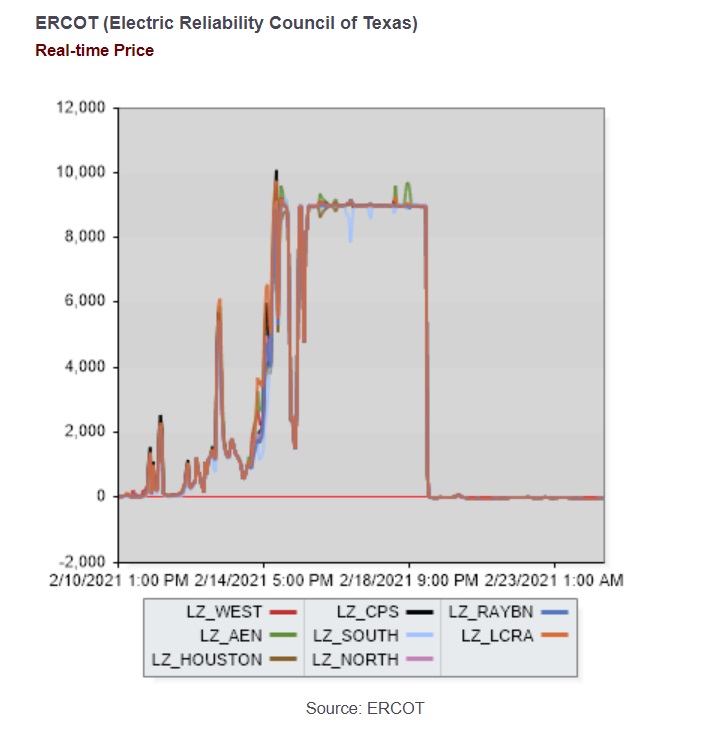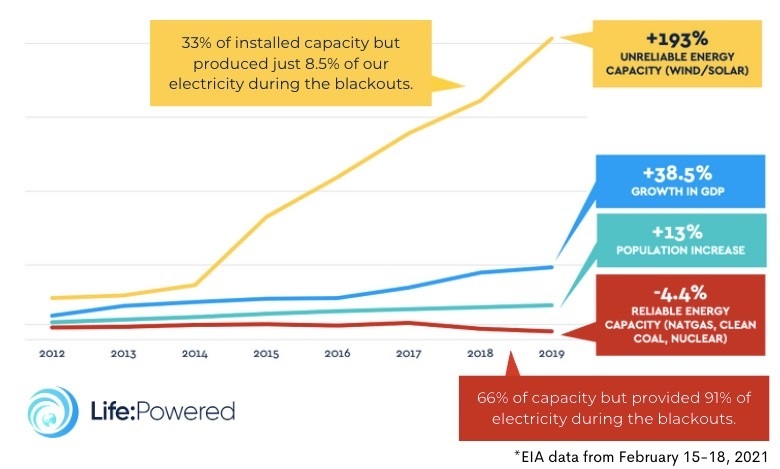Texas wind and solar associations bragged about pushing reliable power plants offline. Then, blackouts
Renewable energy advocates have been working overtime to persuade the public that wind and solar aren’t at fault for the blackouts in Texas.
While these special-interest groups are correct to point out that ERCOT wasn’t expecting the wind to work well and that natural gas supply problems hindered gas-fired generation, they are missing the bigger point: there wasn’t enough reliable capacity on the ERCOT system to meet demand because wind and solar have reduced wholesale power prices in Texas, pushing reliable power plants off the grid.
This isn’t a crazy right-wing conspiracy theory, either. It is something the wind and solar associations in Texas bragged about in 2018. Here’s how it works, in their own words.
PV Magazine is a publication that discusses trends in solar technology. In 2018, they wrote an article outlining the findings of a joint study of the Wind Solar Alliance of Texas. PV Magazine begins the article by saying:
“There is a lot to chew on in The Economic Value of Renewable Energy to Texas, a new report by the Wind Solar Alliance. In addition to numbers on jobs, reduced pollutants, and projected numbers for economic development, there are also figures for revenues to local governments and landowners, all in the cornucopia of economic benefits brought by these two resources.
However, perhaps the most interesting thing in this report – which represents the latest joint effort of the American Wind Energy Association (AWEA) and the Solar Energy Industries Association (SEIA) – are the numbers on how wind, and to a lesser degree solar, are bringing down wholesale power prices and making them more stable.
This speaks to not only how renewable energy is ushering in a new era of super-cheap electricity, but also provides the secret to how wind and solar will increasingly drive more expensive and uncompetitive conventional power plants off the grid in wholesale power markets.”
There are a few things to unpack in this first section. First, wind and solar are bringing down wholesale power prices in Texas, but prices have not become more stable. They have become much more volatile.
During the blackouts in February of 2021, electricity prices hit the $9,000 per megawatt-hour price cap for multiple days, as you can see in the graph below. The day after the blackouts were over, power prices were negative.

The most important part of this paragraph is this sentence: “but [the report] also provides the secret to how wind and solar will increasingly drive more expensive and uncompetitive conventional power plants off the grid in wholesale power markets.“
PV Magazine continues:
In Texas in 2017, this was not a small amount of wind and solar. The 20 GW of wind and 1 GW of solar made up 17.4% and 0.8% respectively of the electricity consumed in the Electric Reliability Council of Texas (ERCOT) grid represented quite a volume of resources bidding in at next to zero.
Particularly when coupled with low gas prices, this is bringing down the cost of generation. As shown in the figure below, at 40 GW of demand and a gas price of $3.50 per MMBTU, even 10 GW of wind and/or solar keeps the bid price just below $30 per megawatt-hour. This prevents not only the most expensive gas plants – such as less efficient simple-cycle plants – from clearing but also most of the coal plants in the fleet.

The graph above shows different power plants bidding into ERCOT’s energy market. Each plant bids in a price based on the marginal cost of generating electricity, and the lowest bidders clear the auction and get to run (see the plants in the black rectangle).
Renewables (in green) displace the coal and natural gas plants (brown and blue) removing them from the auction. Eventually, this can deprive them of enough revenue for them to shut down for good. This is very bad during a polar vortex because it means the plants aren’t online when they’re needed most.
This is just the beginning. Texas continues to add more wind every year, and ERCOT has estimated that the state could put online 13 GW of solar by 2030. This will ultimately mean more hours where coal and gas plants are not operating, and more retirements of conventional generation. [emphasis added]
While the report focuses on Texas, it is not hard to extrapolate this scenario across the entire United States. Significant volumes of wind are present on the MISO grid, and New England saw its first “duck curve” day where mid-day net demand fell to a lower level than overnight demand due to high levels of solar.
It is important to note that the zero marginal cost of wind and solar generation will not discriminate between types of plants, knocking off whatever plants are the most expensive and must run the most to pay off their loans. This is why much of the 110 GW of gas plants planned for the United States may become stranded assets, if utilities and developers insist upon building them.
Texas didn’t have enough reliable capacity to meet the demand for electricity because its energy markets are broken by subsidized wind and solar and market rules that don’t require that power plants be reliable.
Subsidized wind and solar are allowed to participate in the Texas energy market but have no responsibilities to be reliable when needed. This is very bad because it allows them to essentially “dump” power into the market and drive reliable generators, the so-called “uncompetitive conventional power plants,” off the grid.
This is like China dumping steel into the U.S. market to drive our domestic plants out of business. Then when Texas needed the power most, wind and solar faced no penalties for not showing up.
From 2012-2020, Texas increased its capacity for unreliable wind and solar by 193 percent while reliable, dispatchable coal and natural gas capacity fell by 4.4 percent. Wind and solar have skyrocketed because of federal subsidies, and traditional generation has fallen because of low wholesale power prices.

Texas tried to meet rising electricity demand with rising wind and solar levels and falling levels of reliable capacity. The results were predictably terrible. Unfortunately, Texas was set up to fail by the way their power markets are structured to favor renewable energy at the expense of reliable electricity generators. Even the wind and solar companies agree.